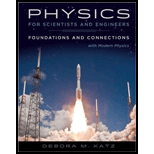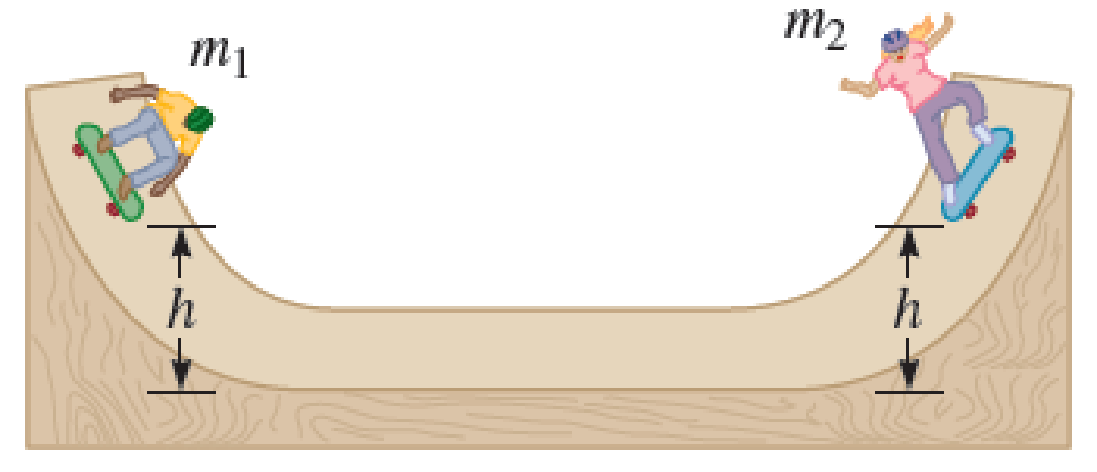
Two skateboarders, with masses m1 = 75.0 kg and m2 = 65.0 kg, simultaneously leave the opposite sides of a frictionless half-pipe at height h = 4.00 m as shown in Figure P11.49. Assume the skateboarders undergo a completely elastic head-on collision on the horizontal segment of the half-pipe. Treating the skateboarders as particles and assuming they don’t fall off their skateboards, what is the height reached by each skateboarder after the collision?

FIGURE P11.49
The height reached by each skateboarder after the collision.
Answer to Problem 49PQ
The height reached by skateboarder of mass
Explanation of Solution
Apply conservation of mechanical energy for each skateboarder as they slide down the surface and collide.
Here,
The collision occur at
Write the expression for
Write the expression for
Here,
Write the expression for
Here, and
Write the expression for
Substitute equations (II),(III),(IV) and (V) in equation (I) to get expression of
Rearrange above equation to get
Equation (VI) indicates that each skateboarder has the same speed when he meets the other skateboarder since they started from the same height.
Let
Since both are at same speed but in opposite direction,
Substitute
Thus,
Write the expression for the velocity of skater with mass
Here,
Write the expression for the velocity of skater with mass
Here,
Equation (VII) can be used to calculate height maximum height attained by skaters if initial velocity is given.
Write the expression for the maximum height attained by first skater.
Here,
Write the expression for the maximum height attained by second skater.
Here,
Conclusion:
Substitute
Substitute
Substitute
Substitute
Therefore, the height reached by skateboarder of mass
Want to see more full solutions like this?
Chapter 11 Solutions
Physics For Scientists And Engineers: Foundations And Connections, Extended Version With Modern Physics
- Question: For a liquid with typical values a = 10-3K-¹ K = 10-4 bar-1 V=50 cm³ mol-1, Cp 200 J mol-1K-1, calculate the following quantities at 300 K and 1 bar for one mole of gas: 1. () P ән 2. (9) T 3. (V) T 4. (1) P 5. (9) T 6. Cv 7. (OF)Tarrow_forwardA,B,C AND Darrow_forwardA bungee jumper plans to bungee jump from a bridge 64.0 m above the ground. He plans to use a uniform elastic cord, tied to a harness around his body, to stop his fall at a point 6.00 m above the water. Model his body as a particle and the cord as having negligible mass and obeying Hooke's law. In a preliminary test he finds that when hanging at rest from a 5.00 m length of the cord, his body weight stretches it by 1.55 m. He will drop from rest at the point where the top end of a longer section of the cord is attached to the bridge. (a) What length of cord should he use? Use subscripts 1 and 2 respectively to represent the 5.00 m test length and the actual jump length. Use Hooke's law F = KAL and the fact that the change in length AL for a given force is proportional the length L (AL = CL), to determine the force constant for the test case and for the jump case. Use conservation of mechanical energy to determine the length of the rope. m (b) What maximum acceleration will he…arrow_forward
- 210. Sometimes the Helmholtz free energy F(T, V, N) divided by temperature, T, is an interesting quantity. For example, the quantity is proportional to the logarithm of the equilibrium constant or solubilities. A. Derive a relationship showing that Find the constant of proportionality. a F αυ ƏT T B. Suppose F(T) depends on temperature in the following way: F(T)=2aT²+bT. Find S(T) and U(T).arrow_forwardchoosing East (e) is not correct!arrow_forwarddisks have planes that are parallel and centered Three polarizing On a common axis. The direction of the transmission axis Colish dashed line) in each case is shown relative to the common vertical direction. A polarized beam of light (with its axis of polarization parallel to the horizontal reference direction) is incident from the left on the first disk with int intensity So = 790 W/m². Calculate the transmitted intensity if 81=28.0° O2-35.0°, and O3 = 40.0° w/m² horizontal Өз 02arrow_forward
- A polarized light is incident on several polarizing disks whose planes are parallel and centered on common axis. Suppose that the transmission axis of the first polarizer is rotated 20° relative to the axis of polarization of the incident and that the transmission axis of each exis of light, additional analyzer is rotated 20° relative to the transmission axis the previous one. What is the minimum number of polarizer needed (whole number), so the transmitted light through all polarizing sheets has an Striking intensity that is less then 10% that the first polarizer?arrow_forwardA high energy pulsed laser emits 1.5 nano second-long pulse of average power 1.80x10" W. The beam is cylindrical with 2.00 mm in radius. Determine the rms value of the B-field? -Tarrow_forwardA 23.0-mw (mill:-Watts) laser puts out a narrow cyclindrical beam 50 mm in diameter. What is the average N/C. rms E-field?arrow_forward
- The average intensity of light emerging from a polarizing sheet is. 0.550 W/m², and the average intensity of the horizontally polarized light incident on the sheet is 0.940 W/m². Determine the angle that the transmission axis of the polarizing sheet makes with the horizontalarrow_forwardwe measure an At a particular moment in time and space, electromagnetic wave's electric and magnetic fields. We find the electric field & pointing North and the magnetic field B pointing Down. What is the direction of wave propagation? a. South b. West C. c. Up d. Down e. East f. North.arrow_forwardHello, please help with how to calculate impact velocity and rebound velocity. Thanks!arrow_forward
 Physics for Scientists and Engineers: Foundations...PhysicsISBN:9781133939146Author:Katz, Debora M.Publisher:Cengage Learning
Physics for Scientists and Engineers: Foundations...PhysicsISBN:9781133939146Author:Katz, Debora M.Publisher:Cengage Learning Principles of Physics: A Calculus-Based TextPhysicsISBN:9781133104261Author:Raymond A. Serway, John W. JewettPublisher:Cengage Learning
Principles of Physics: A Calculus-Based TextPhysicsISBN:9781133104261Author:Raymond A. Serway, John W. JewettPublisher:Cengage Learning Physics for Scientists and Engineers with Modern ...PhysicsISBN:9781337553292Author:Raymond A. Serway, John W. JewettPublisher:Cengage Learning
Physics for Scientists and Engineers with Modern ...PhysicsISBN:9781337553292Author:Raymond A. Serway, John W. JewettPublisher:Cengage Learning Physics for Scientists and EngineersPhysicsISBN:9781337553278Author:Raymond A. Serway, John W. JewettPublisher:Cengage Learning
Physics for Scientists and EngineersPhysicsISBN:9781337553278Author:Raymond A. Serway, John W. JewettPublisher:Cengage Learning University Physics Volume 1PhysicsISBN:9781938168277Author:William Moebs, Samuel J. Ling, Jeff SannyPublisher:OpenStax - Rice University
University Physics Volume 1PhysicsISBN:9781938168277Author:William Moebs, Samuel J. Ling, Jeff SannyPublisher:OpenStax - Rice University Physics for Scientists and Engineers, Technology ...PhysicsISBN:9781305116399Author:Raymond A. Serway, John W. JewettPublisher:Cengage Learning
Physics for Scientists and Engineers, Technology ...PhysicsISBN:9781305116399Author:Raymond A. Serway, John W. JewettPublisher:Cengage Learning





